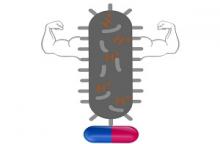- About us
- Research
- Students & Teaching
- Seminars & Events
- Directories
- Booking Rooms & Equipment
- עברית
Home » Prof. Schuldiner shows that acidic cytoplasm is related to antibiotic resistance
The discovery of antibiotics changed the face of medicine, and made it possible to save the lives of millions of people. Unfortunately, with the development of antibiotics, bacteria resistant to antibiotics also appeared. This resistance is now a serious threat to public health, and requires the development of new drugs. The aim of our research is to understand the mechanisms of resistance, and to use this knowledge to overcome them.
In order to understand the process of acquiring resistance to antibiotics, we have previously isolated species of intestinal bacteria resistant to very high concentrations of antibiotics in our laboratory. In this process, we exposed sensitive bacteria to sublethal concentrations of antibiotics of two types simultaneously:
After a day of growth, we increased the concentration twice and so we continued for about 20 days. At the end of the process, we isolated and characterized mutants capable of growing at antibiotic concentrations 4000 times higher than the initial concentration.
While characterizing the resistant species, we found that their cytoplasm is more acidic than that of sensitive species. Bacteria that are exposed to various stress, such as antibiotics or other toxic substances, are known to respond by activating a defense system that includes about 50 different genes, whose expression changes, and by that increases the bacterium's chances of surviving in a hostile environment.
We have now found that as a result of activating this system the acidity of the cytoplasm increases. In mutants where this defense system has been silenced by us, we have also been able to change the acidity with the help of various substances, and we have shown a clear connection between the acidity of the cytoplasm and resistance to antibiotics.
The acidification of the cytoplasmic pH is caused by activation of the marRAB operon. The acidification itself contributes to a full manifestation of the antibiotic resistance phenotype. Similarly, we have shown that exposure of antibiotic-sensitive cells to weak acids that caused cytoplasmic acidification, resulted resistance, regardless of the marRAB response.
It has been known for several decades that the acidity regulation of the cytoplasm is essential for the proper existence of most biological processes that take place in the cell. It was therefore very surprising that in resistant bacteria the acidity is different. We assume that the cytoplasmic pH decrease caused by activating the response to marRAB, provides a signaling mechanism that differentiates metabolic pathways in the cell, and is used to deal with stress and lowering metabolic costs.
This work reveals for the first time a previously unrecognized consequence of the bacterial response to antibiotic stress. We continue to investigate how an increase in acidity helps to cope with this stress, and hope that understanding this effect will help us develop new strategies for dealing with the epidemic of antibiotic resistance.
